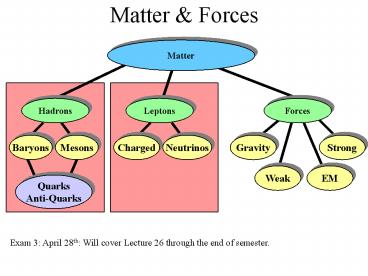Matter - PowerPoint PPT Presentation
1 / 26
Title:
Matter
Description:
Exam 3: April 28th: Will cover Lecture 26 through the end of semester. ... e) b and b (Mb ~ 4.8 GeV) Y or N. f) t and t (Mt ~ 175 GeV) Y or N. Photon Conversion ... – PowerPoint PPT presentation
Number of Views:55
Avg rating:3.0/5.0
Title: Matter
1
Matter Forces
Matter
Leptons
Forces
Charged
Neutrinos
Strong
Gravity
Weak
EM
Exam 3 April 28th Will cover Lecture 26 through
the end of semester.
2
A Sense of Scale
Quarks and leptonsare the most
elementaryparticles we know aboutat this time.
They are nolarger than 10-18 cm
3
The Standard Model
- Quarks and leptons are the most fundamental
particles of nature that we know about. - Up down quarks and electrons are the
constituents of ordinary matter. - The other quarks and leptons can be produced in
cosmic ray showers or in high energy particle
accelerators. - Each particle has a correspondingantiparticle.
4
The cast of quarks leptons
5
Quarks versus Leptons
What are the primary differences between quarks
and leptons?
Ultimately, what differentiates the quarks
leptons from oneanother are the forces which
each may exhibit.
We therefore now embark on the concept of forces.
6
The Four Fundamental Forces
- Gravity
- Weak Force
- Electromagnetic force
- Strong Force
Doesnt that looklike George W. ?
All other forces you know about can be attributed
to one of these!
7
Gravity
Gravity is the weakest of the 4 forces. The
gravitational force between two objects of
masses m1 and m2, separated by a distance d
is F Gm1m2/d2 G
gravitational constant 6.7x10-11Nm2/kg2 d
distance from center-to-center The units of each
are Force Newton N mass kg
distance meters Gravity is only an
attractive force
8
The Electric Force
In the old days, we believed that force was
transmitted more orless instantaneously by a
field of force.
Lines of force
The proton to the right is repelled by the
electric field created bythe one on the left
(electrical repulsion).
9
The New Concept of Force
In the 1960s, a new theory of interactions was
developed.At the heart of it is the concept
that
Richard Feynman, 1918-19881965 Nobel Prize in
Physics
Forces are the result of the exchange of force
carriers between the two particles involved in
the interaction.
The force carrier of the electromagnetic force is
the photon (g)
10
The Photon (g)
- The photon is the mediator of the
electromagnetic interaction - The photon can only interact with objects which
have electric charge !!!!!
11
As we go through these slides,note that all
particles involved(other than the photon)carry
electrical charge!
12
Electron-Positron Scattering
e e- ? e e-
13
Electron-Positron Scattering
e e- ? e e-
e
e
e
e
e
e-
e-
e-
e-
e-
e-
14
Electron-Positron Annihilation
e e- ? e e-
15
Electron-Positron Annihilation
e e- ? e e-
16
Quark Pair Production
e e- ? q q
Note Two completely different particles in the
final state. Sincequarks have electric charge,
this can in fact happen!
17
Quark Pair Production
e e- ? q q
e
q
q
q
g
e-
Note Two completely different particles in the
final state
18
Example
In the preceding example, assume that the
incoming electron andpositron each have energy
of 5 GeV.
1. What is the energy of the photon after the
electron positron annihilate? A) 5 GeV
B) 10 GeV C) 0 GeV D) None of these
2. Assuming that the final state electron
positron have equal energy, what is the
energy of the emergent electron ? A) 5
GeV B) 10 GeV C) 0 GeV D) None of these
19
Photon Conversion
g ? e e-
20
Photon Conversion
g ? e e-
e
e
e
g
g
e-
e-
e-
21
Quark Antiquark Annihilation
q q ? e e-
Note Reverse process to quark pair production!
22
Quark Antiquark Annihilation
q q ? e e -
e
e
e
g
e-
e-
e-
Note Reverse process to quark pair production!
23
Feynman Diagrams
- A great simplification which allows us to
represent these physical processes are
facilitated by Feynman Diagrams. - It turns out, they can also be used to calculate
the probability for the process to occur
(Beyond the scope of this module though). - We will use them more in a qualitative sense to
visualize various processes.
24
Feynman Diagrams
25
Photon Conversion and Emission
26
More Feynman Diagrams
Quark PairProduction
q
e
- q can be any quark,as long as there isenough
energy to create2 of em!
g
e-
Quark AntiquarkAnnihilation toElectron
Positron
q
e
g
e-































